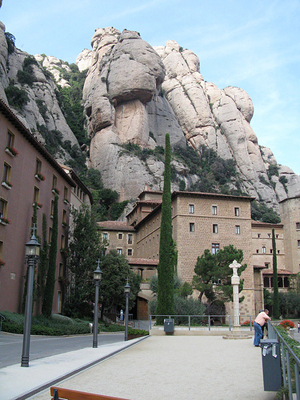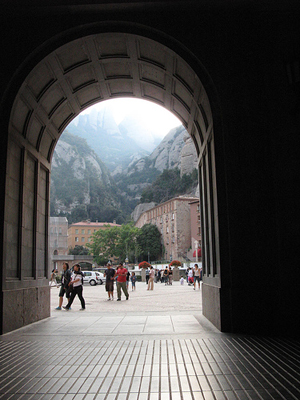 |
||||||||||
 |
||||||||||
|
1512: Abbey of Our Lady, Montserrat, Catalonia, Spain Mystery Worshipper: Augustine the Aleut. The church: Abbey of Our Lady, Montserrat, Catalonia, Spain. Denomination: Roman Catholic. The building: The basilica is the shrine of the Black Madonna (La Moreneta), who is one of the symbols of Christianity in Catalonia. The 15th century building burned down during the Napoleonic wars, and so the huge abbey church is fairly modern, although with the baroque retabloes and other accoutrements of Iberian Catholicism. The building was reconsecrated in 1901 and the abbey itself restored and completed in 1968. The monks maintain a publishing house, which was one of the centres of Catalan literary life during the Franco period, when the only (barely tolerated) expression of the language was through Bibles and devotional literature. As well, there is an internationally-renowned choral school. The church: The abbey's scriptorium, where monks copied books, is still active as a place of research and publication. A project is underway to preserve ancient manuscripts in digital format. The abbey also offers several programs of spiritual counseling to its visitors. The neighbourhood: There's really no neighbourhood, although there is an ancient apartment complex, presumably housing those who are employed at the abbey, the choral school, and the retreat facilities. The monastery and the buildings are parked on the side of a huge serrated rock pile – the poet José Pla wrote that it is something which does not look like anything. Wilfred the Hairy, Count of Barcelona, recaptured the area from the Moors in 888 and established a monastery, although the current set-up only dates from 1025. Millennium celebrations are planned for 2025. The cast: No idea – there were about 30 monks, and about 80 or so choristers. The date & time: Sunday, 2 September 2007, 6.45pm. What was the name of the service? Vespers. How full was the building? In a building that could potentially hold over a thousand or so, there were about 400 present, including tourists and pilgrims to the shrine – numbers that would inspire catatonic fits from the dean for evensong in most Canadian cathedrals. In front of me were about half a dozen members of a Muslim family, the women in headscarves, quietly paying attention to the service. Did anyone welcome you personally? Not here... but at an open air mass the next morning, I was welcomed in a way that I will never forget. Read on. Was your pew comfortable? It was a typical solidly-crafted wooden pew, possibly seating up to 20. I don't recall it as being particularly comfortable. How would you describe the pre-service atmosphere? Like most tourist or pilgrim shrines, it was quite noisy, and a good chunk of the congregation couldn't bear to cease their conversations. Another portion was likely not certain exactly what to do in a church nor why they were there. The atmosphere was more hectic and entertaining than devotional. What were the exact opening words of the service? No idea, but it was likely in Catalan, and I could barely hear over the noise. What books did the congregation use during the service? This seemed to be more of a spectator event than a service where participation was expected. In any case, no books were available in the pews. What musical instruments were played? A powerful organ with a vigorous organist. The boys' choir sang the Salve and a motet. Did anything distract you? With several hundred people milling about, sitting down, and rising and leaving as they wished, the entire operation was distracting. Was the worship stiff-upper-lip, happy clappy, or what? The monks and choristers bravely charged ahead with their duties, and did so with sufficient force and volume that they prevailed. The style was a mix of novus ordo, monastic, and choir school.  Exactly how long was the sermon? 10 minutes. On a scale of 1-10, how good was the preacher? 8 – based on the fact that it was a cheerful, 10-minute homily in Catalan, which everybody seemed to enjoy. The preacher was at quite a distance from me, but knew how to handle a microphone effectively. In a nutshell, what was the sermon about? I only caught a few words, as it was in Catalan, which is even more difficult for me than is Castilian Spanish. He might have been preaching in Ojicree or Coastal Salish for all I understood. Which part of the service was like being in heaven? The choristers' singing, which was transcendent and powerful enough to collect us all from our distractions and our different reasons for being here. Also, being able to follow my way through the order for vespers. And which part was like being in... er... the other place? It was not clear to me if it was a service of worship or a performance of some sort. What happened when you hung around after the service looking lost? Everyone else looked lost, so I just blended in. I peered at a few monuments and caught the eyes of a few confused German and Muslim tourists, and we exchanged mutual smiles of non-Catalanhood (this is also a shrine of Catalan identity). How would you describe the after-service coffee? There was a restauranta handy and, as I was still recuperating from my overnight flight from Ottawa via Frankfurt, and trying to redeem lost luggage, I simply headed off for a light meal of asparagus salad and grilled shrimp, and then collapsed. How would you feel about making this church your regular (where 10 = ecstatic, 0 = terminal)? 4 – I think that I would have to involve myself somehow in the abbey's programs and ministries, or even the choir school, to get much out of it. Did the service make you feel glad to be a Christian? Well, I like vespers, so it wasn't a bad experience. What one thing will you remember about all this in seven days' time? From this particular service, little. From the Abbey’s spectacular setting and history, a sense of how history’s currents add another layer to religious experience. And, the next morning, I headed down the trail beyond the Abbey, as instructed, and found myself walking along the side of the mountain on a broad path, flanked by trees, and overlooking the heights to Manresa in the valley below. Turning a corner to a stone pergola, I encountered a group of 40-50 Catalans attending an open-air mass and blocking the trail. As the priest was well into the prayer of consecration, I knew that I would not have to wait long and so I removed my trusty Tilley hat, respectful-like, and stood to the side. After the priest communicated himself and two of the lay assistants came up to help him, he signalled to me to come up to receive. I approached and quietly said in Castilian Spanish that I was Anglican, not Roman Catholic. "Are you a pilgrim to Santiago?" he asked and I nodded. He answered: "Then come, this is for you. This is for your journey." As I left, passing through the group, a spiky-haired and lip-pierced lass in her early teens gave me a light friendly punch on the shoulder, saying: Cami en el ombre, hombre ("Walk in the shade, dude"). More Camino reports |
|
|
||||||||||||||||||||||||||||||||||||
| More Mystery Worshipper reports | |||||||||||||||||||||||||||||||||||||||
 |
|||||||||||||||||||||||||||||||||||||||






